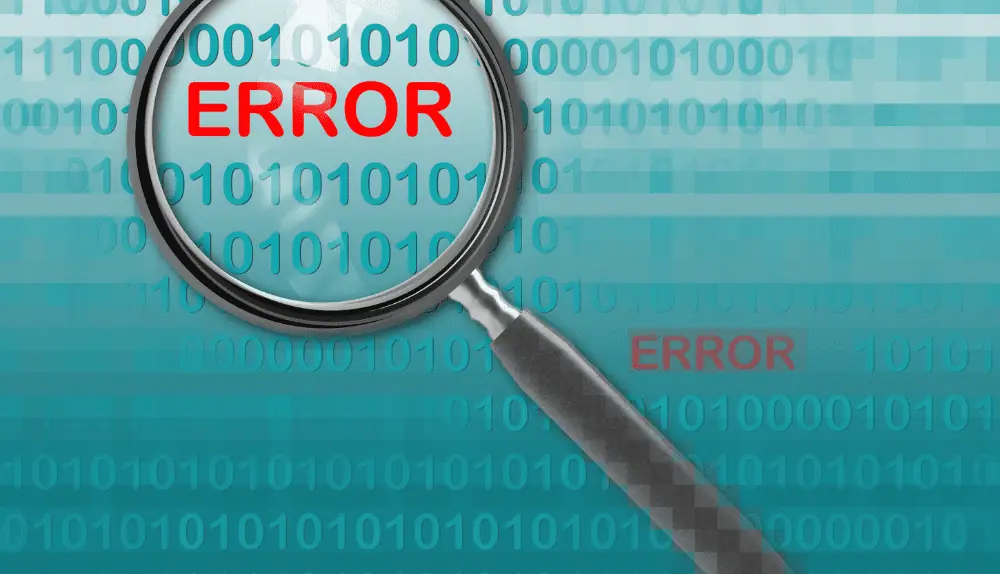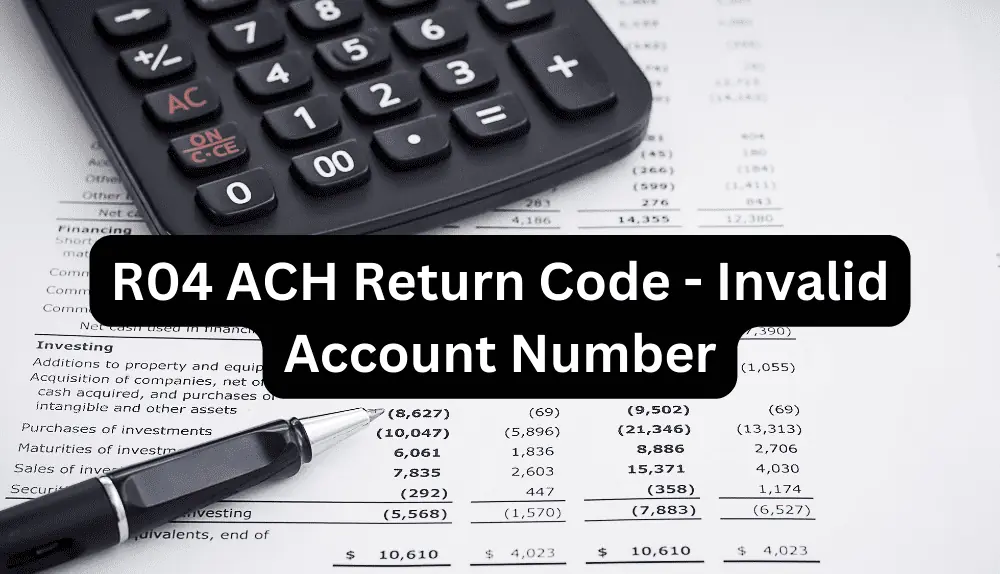In the fast-paced world of electronic payments and digital transactions, the efficiency and reliability of the Automated Clearing House (ACH) system have revolutionized the way we handle our finances. But like any technological marvel, it’s not immune to occasional hiccups. Enter the enigmatic “R04 ACH Return Code – Invalid Account Number,” a cryptic error that has left many scratching their heads.
Just as every puzzle has its key, understanding this elusive return code is crucial for navigating the intricate landscape of ACH transactions. So, join me as we unravel the secrets behind R04, exploring its implications, causes, and the measures we can take to keep our financial world spinning smoothly. Get ready to dive into the realm of payment intricacies, where decoding the mysterious “Invalid Account Number” holds the key to seamless electronic exchanges!
What Does R04 ACH Return Code Mean?
The ACH R04 return code denotes an “Invalid Account Number” within the Automated Clearing House (ACH) system, signaling that the account number provided in a particular transaction is incorrect or does not match the account holder’s information. When an ACH payment is initiated, the receiving bank conducts a series of validations to ensure the transaction’s accuracy and legitimacy. If the account number provided does not correspond to a valid account or contains errors, the payment cannot be successfully processed, leading to the issuance of the R04 return code.
Several reasons may trigger this error. It could be as simple as a typo in the account number or even the omission of essential digits. Additionally, if the account has been closed or is inactive, the ACH transaction will be rejected with the R04 code. Furthermore, issues with the financial institution’s internal database or data transmission errors can also contribute to the generation of the R04 return code.
To rectify this situation, it is vital for both the sender and the receiver of the ACH transaction to carefully cross-verify the account information before initiating or accepting any payment. In cases of typographical errors, the sender can amend the account details and reinitiate the transaction. For more serious issues, such as a closed account, the parties involved should directly communicate and seek alternative payment methods to ensure a smooth and successful financial exchange. Understanding and addressing the implications of the ACH R04 return code is crucial for maintaining the integrity and efficiency of electronic payment systems.
Reasons R04 ACH Return Code Can Occur
The ACH R04 return code, which indicates an “Invalid Account Number,” can occur due to various reasons within the Automated Clearing House (ACH) system. These reasons typically involve discrepancies or issues with the account information provided during the transaction initiation. Understanding these reasons is essential for preventing and addressing ACH payment failures and ensuring the smooth functioning of electronic transactions.
Incorrect Account Number
One of the most common reasons for the R04 return code is an incorrect account number provided by the sender. A simple typographical error, such as a misplaced digit or transposed numbers, can lead to the invalidation of the account, preventing the transaction from going through.
Closed or Inactive Account
If the account number provided by the sender corresponds to an account that has been closed or is inactive, the ACH payment will be rejected with the R04 code. It is crucial to verify the account’s status before initiating any transaction to avoid this issue.
Account Number Structure
Financial institutions often have specific rules for the structure of account numbers. If the provided account number does not adhere to the required format, it may trigger the R04 return code.
Routing Number Errors
In some cases, errors in the routing number provided for the receiving bank can lead to an R04 return code. The routing number identifies the bank where the account is held and is essential for routing the ACH transaction correctly.
Data Transmission Errors
During the transmission of ACH data between financial institutions, errors may occur, leading to incorrect or incomplete account information. Such discrepancies can result in the R04 return code.
Account Holder Name Mismatch
Occasionally, the name provided in the transaction does not match the account holder’s name on record with the receiving bank, leading to a rejection of the ACH payment.
Frozen Accounts or Compliance Issues
In some cases, accounts may be frozen due to suspected fraudulent activity or compliance issues, resulting in the ACH transaction being declined.
To prevent the ACH R04 return code, both the sending and receiving parties should exercise due diligence. Before initiating a transaction, the sender must double-check all account information, including the routing and account numbers and the account holder’s name. On the recipient’s end, thorough verification of incoming ACH transactions can help identify potential issues and facilitate timely communication with the sender to rectify any discrepancies. By being vigilant about account information and maintaining effective communication channels, businesses and individuals can minimize ACH payment failures and ensure the efficient processing of electronic transactions.
Solutions to Fix R04 ACH Return Code
Fixing the ACH R04 return code, denoting an “Invalid Account Number,” requires prompt action and collaboration between both the sender and receiver of the transaction. Addressing this issue effectively involves identifying the root cause and implementing appropriate solutions to prevent future occurrences. Here are some strategies to resolve the ACH R04 return code and ensure the successful processing of electronic payments:

Account Number Verification
Before initiating any ACH transaction, it is crucial to verify the account number carefully. The sender should double-check all account information, including the account number and routing number, to ensure accuracy. Using verification tools and software can help reduce the risk of typographical errors during data entry.
Account Number Structure Compliance
Financial institutions often have specific rules for the structure of account numbers. Businesses and individuals should familiarize themselves with the formatting requirements and ensure that the provided account number adheres to these guidelines.
Account Status Check
To avoid issues with closed or inactive accounts, the sender should verify the account’s status with the receiving bank before initiating the transaction. Ensuring the account is active and in good standing is essential for successful ACH processing.
Communication with the Receiving Bank
If the ACH R04 return code occurs due to an issue on the receiving bank’s end, such as a data transmission error or account freeze, open communication with the bank is vital. Promptly notifying the bank about the error can facilitate a timely resolution.
Correcting Data Transmission Errors
In cases where data transmission errors are suspected, both the sending and receiving banks should investigate the issue. Implementing error-checking mechanisms during data transmission can help identify and rectify errors promptly.
Name Verification
Ensuring that the name provided in the transaction matches the account holder’s name on record with the receiving bank is crucial. If there is a discrepancy, the sender should update the information and reinitiate the transaction.
Alternative Payment Methods
In situations where the account number cannot be verified or corrected, exploring alternative payment methods becomes necessary. This could involve using a different account or opting for other payment channels, such as credit cards or checks.
ACH Transaction Limits
Some ACH payment processing platforms offer transaction limit settings. Ensuring that the transaction amounts fall within the specified limits can prevent ACH R04 return codes due to exceeding limits.
Continuous Monitoring and Process Improvement
Regularly reviewing ACH transactions and their outcomes can help identify recurring issues and areas for improvement. Implementing feedback loops and process enhancements can minimize the occurrence of ACH return codes over time.
By taking a proactive approach and implementing these solutions, businesses and individuals can significantly reduce the occurrence of ACH R04 return codes. Preventing payment failures not only saves time and effort but also contributes to a smoother and more efficient financial ecosystem for all parties involved in electronic transactions.
How Businesses Can Deal with R04 ACH Return Code?
When faced with the ACH R04 return code, businesses can effectively address the issue through a systematic approach. First and foremost, they should promptly communicate with the customer or vendor whose transaction was affected, informing them of the situation. Next, thorough verification of the provided account information, including account number, routing number, and account holder’s name, is essential to identify potential errors.
Open communication with the customer or vendor is crucial to validate and rectify any discrepancies in the account details. If the issue was due to an incorrect account number or a closed account, the business can attempt the payment again after verifying the correct information. Alternatively, exploring alternative payment methods, such as credit cards or checks, may be necessary.
To prevent future ACH R04 return codes, businesses should educate customers and vendors on the importance of providing accurate and up-to-date account information. Implementing error-checking mechanisms during data entry and maintaining accurate customer records can help minimize the risk of return codes. Regularly reviewing and updating payment policies and procedures can further enhance the ACH payment process, ensuring smoother transactions and fostering stronger relationships with customers and partners.
Final Words
In conclusion, understanding and effectively dealing with the ACH R04 return code, indicating an “Invalid Account Number,” is essential for businesses navigating the realm of electronic transactions. By implementing proactive measures such as thorough verification of account information, open communication with customers and vendors, and the use of error-checking mechanisms, businesses can significantly reduce the occurrence of ACH return codes.
Educating customers and vendors about the importance of providing accurate details and maintaining up-to-date records further strengthens the payment process. Additionally, regularly reviewing and updating internal payment policies and procedures ensures alignment with industry best practices, fostering a smoother and more efficient financial ecosystem. Through diligent efforts and continuous improvement, businesses can minimize disruptions, build trust with their partners, and promote seamless ACH transactions, ultimately contributing to a thriving and reliable electronic payment landscape for all stakeholders involved.
Frequently Asked Questions (FAQs)
What should I do if I receive an ACH R04 return code notification?
If you receive an ACH R04 return code notification, promptly communicate with the affected customer or vendor. Verify the account information provided, and if necessary, contact the customer or vendor to rectify any discrepancies. Consider reattempting the payment with the correct account details or exploring alternative payment methods.
How can I prevent ACH R04 return codes?
To prevent ACH R04 return codes, ensure thorough verification of account information before initiating transactions. Implement error-checking mechanisms during data entry and regularly update customer or vendor records. Educate customers and vendors on the importance of providing accurate account details.
Are there transaction limits for ACH payments?
Some ACH payment processing platforms offer transaction limit settings. Setting transaction limits can help protect against large or unauthorized transactions and mitigate the risk of ACH return codes.
What happens if an ACH transaction is returned with an R04 code?
When an ACH transaction is returned with an R04 code, the funds are not successfully transferred to the recipient's account. The sender may need to correct the account information and initiate the payment again.

